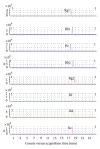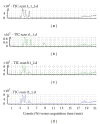A metabolomics-based strategy for the quality control of traditional chinese medicine: shengmai injection as a case study
- PMID: 23401718
- PMCID: PMC3562660
- DOI: 10.1155/2013/836179
A metabolomics-based strategy for the quality control of traditional chinese medicine: shengmai injection as a case study
Abstract
Quality control of traditional Chinese medicines (TCMs) used clinically is becoming a challenge and has limited the development of TCM due to the high variability in concentration levels of active ingredients and markers as well as the lack of well-established criteria. Using Shengmai injection, which is a well-established TCM, as an example, we developed an integrated profiling approach that simultaneously captures the entire spectrum of ingredients and quantitatively determines the levels of seven key ingredients in the TCM product. A multivariate statistical model was constructed to establish a "seven-marker-" based quality standard that qualified the majority of samples in this study. This newly developed strategy showed that a panel of key ingredients or markers in the TCM product were relatively consistent within a statistically acceptable range. Therefore, this metabolomics-based approach will complement the current quality control standard using the concentration of several key ingredients or their total content and help improve the consistency and clinic efficacy of TCM products.
Figures





Similar articles
-
A Strategy for Selecting "Q-Markers" of Chinese Medical Preparation via Components Transfer Process Analysis with Application to the Quality Control of Shengmai Injection.Molecules. 2019 May 10;24(9):1811. doi: 10.3390/molecules24091811. Molecules. 2019. PMID: 31083349 Free PMC article.
-
Discovery of potential Q-marker of traditional Chinese medicine based on plant metabolomics and network pharmacology: Periplocae Cortex as an example.Phytomedicine. 2021 May;85:153535. doi: 10.1016/j.phymed.2021.153535. Epub 2021 Mar 2. Phytomedicine. 2021. PMID: 33819766
-
An integrated approach to uncover quality markers of Traditional Chinese medicine underlying chemical profiling, network target selection and metabolomics approach: Guan-Xin-Jing capsule as a model.J Pharm Biomed Anal. 2020 Oct 25;190:113413. doi: 10.1016/j.jpba.2020.113413. Epub 2020 Aug 1. J Pharm Biomed Anal. 2020. PMID: 32781322
-
[Chinmedomics: a new strategy for research of traditional Chinese medicine].Zhongguo Zhong Yao Za Zhi. 2015 Feb;40(4):569-76. Zhongguo Zhong Yao Za Zhi. 2015. PMID: 26137671 Review. Chinese.
-
From quality markers to data mining and intelligence assessment: A smart quality-evaluation strategy for traditional Chinese medicine based on quality markers.Phytomedicine. 2018 May 15;44:109-116. doi: 10.1016/j.phymed.2018.01.017. Epub 2018 Jan 31. Phytomedicine. 2018. PMID: 29426601 Review.
Cited by
-
Research Progress in Chinese Herbal Medicines for Treatment of Sepsis: Pharmacological Action, Phytochemistry, and Pharmacokinetics.Int J Mol Sci. 2021 Oct 14;22(20):11078. doi: 10.3390/ijms222011078. Int J Mol Sci. 2021. PMID: 34681737 Free PMC article. Review.
-
Effect of Traditional Chinese Medicine on the Cardiovascular Diseases.Front Pharmacol. 2022 Mar 21;13:806300. doi: 10.3389/fphar.2022.806300. eCollection 2022. Front Pharmacol. 2022. PMID: 35387325 Free PMC article. Review.
-
The anticancer activity and mechanisms of She medicine herbs.Front Pharmacol. 2025 Jul 17;16:1610301. doi: 10.3389/fphar.2025.1610301. eCollection 2025. Front Pharmacol. 2025. PMID: 40746719 Free PMC article. Review.
-
Identification of anti-inflammatory components in Panax ginseng of Sijunzi Decoction based on spectrum-effect relationship.Chin Herb Med. 2022 Oct 17;15(1):123-131. doi: 10.1016/j.chmed.2022.04.003. eCollection 2023 Jan. Chin Herb Med. 2022. PMID: 36875431 Free PMC article.
-
Cardiotonic modulation in heart failure: insights from traditional Chinese medicine.J Am Coll Cardiol. 2013 Sep 17;62(12):1073-1074. doi: 10.1016/j.jacc.2013.05.028. Epub 2013 Jun 7. J Am Coll Cardiol. 2013. PMID: 23747774 Free PMC article.
References
-
- Gilbert N. Chinese Herbal Medicine Breaks into EU Market. 2012.
-
- Mahady GB, Fong HS, Farnsworth NR. Botanical Dietary Supplements: Quality, Safety, and Efficacy. Amsterdam, The Netherlands: Swets & Zeitlinger; 2001.
-
- Di X, Chan KKC, Leung HW, Huie CW. Fingerprint profiling of acid hydrolyzates of polysaccharides extracted from the fruiting bodies and spores of Lingzhi by high-performance thin-layer chromatography. Journal of Chromatography A. 2003;1018(1):85–95. - PubMed
-
- FDA Guidance for Industry—Botanical Drug Products (Draft Guidance) Rockville, Md, USA: US Food and Drug Administration; 2000.
-
- Note for Guidance on Quality, of Herbal Medicinal Products. London, UK: European Medicines Agency; 2001.
LinkOut - more resources
Full Text Sources
Other Literature Sources

